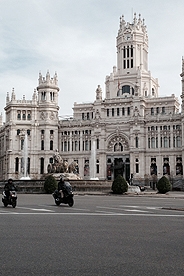Some of the world’s best art museums are located in Madrid. Do not leave Madrid without visiting each of them several times! The three most well-known museums in Madrid are:
- Museo Nacional del Prado
- Museo Thyssen-Bornemisza
- Museo Reina Sofia
Also, ask your professors for other recommendations for museums beyond these big three. You will have inevitably heard of El Prado. Probably the city’s most well-known museum, the Prado houses some of the finest European art as well as one of the best single collections of Spanish art. The Reina Sofia focuses mainly on 20th century Spanish art and has huge collections of Picasso and Dalí as well as works by Miró, Juan Gris and other Spanish artists.
While in Madrid, take some time to explore Retiro Park, el Parque del Retiro. The park spans about 350 acres, contains a pond where you can rent paddle boats and kayaks, and boast many monuments, statues, and architectural wonders. And you can’t miss Plaza Mayor located in the center of Madrid. This is a wonderful place to relax, meet up, or start your evening. Not too far from Plaza Mayor is Palacio Real, Madrid’s Royal Palace built in 1764. You can take a tour of many of the rooms within the palace, learn about the history of the Spanish Kings and Queens, and admire the exquisite architecture and art. Lastly, you should take some time to explore the architecture, monuments, and history of Puerta del Sol, located in the center of Madrid at the crossroads of many major boulevards and streets throughout Madrid. This is another great location to meet up with friends before heading out to see more of the city. You will find that Madrid has so many wonderful public spaces, palaces, museums, theaters, and street art that you simply cannot catalogue it all. You will find your favorite parts of Madrid and come to refer to them your local meet up and hang out spots.
You should definitely take the opportunity to travel within Spain during the semester. Travel by train and by bus is very affordable, though buses go more places and tend to be less expensive. If you are able to get a student identification card from the university in Madrid, you can get the Carné Joven, which entitles you to 50% off all train travel in Spain. There are many places near Madrid that are easy to reach by a short bus ride or train trip, such as Toledo, Segovia, Salamanca, Burgos, Cuenca, El Escorial, Valle de los Caídos, La Rioja, Avila, Aranjuez, and Palencia. There may be organized trips with the whole group to some of these locations.
Spain is well known for its fiestas, celebrating every religious holiday. The Carnavales are big in Cádiz. Around Ash Wednesday there are plenty of activities in Plaza Mayor in Madrid. Holy Week, Semana Santa, has especially grandiose celebrations in Granada and Sevilla. Any tour book will list and describe the fiestas. Popular areas to visit are Costa del Sol, Barcelona, País Vasco, Valencia, or Galicia. Spain is rich in diversity of culture, geography, and activity. Bring good walking shoes and explore as much as you can!
We encourage you to limit your personal travel to within Spain. This is your one chance to really get to know one single country very well. Travel throughout Spain and limit your travel to other European cities as much as you can. Keep in mind that personal travel must NOT interfere with program classes, activities, or field trips.

